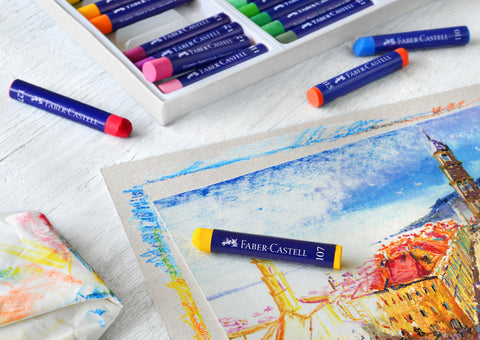Pastel Art 101: Comparing Pencil, Soft, and Oil Pastels

Pastels are an artistic media unlike any other bringing artists access to vibrant pigments right at their fingertips in the form of sticks or pencils. Pastel artwork can be intimidating when first approached but learning what kind of pastel is right for your artwork is the first step in achieving your artistic goals and mastering the medium. Faber-Castell offers pastels in soft, oil, hard, and pencil form.
Polychromos Pastel Crayons
Pitt Pastel Pencils:
Pastel Pencils are an artist’s best friend when it’s time to get detailed. Faber-Castell Pitt Pastel Pencils offer 60 highly pigmented colors that are high-quality and lightfast. Wax-free and oil-free, these pastels are perfectly suited for fine and elaborate detail while their content allows for easy smudging to create fine color transitions. Pitt Pastel Pencils are available in tins of 60, 36, 24, and 12 as well as individually.
Soft Pastels:
Faber-Castell Soft Pastels set themselves apart from our oil pastels with 70 colors in the form of standard and mini rectangular sticks. Pigment mixed with minimal binders and compression are what give soft pastels their gentle smooth laydown. With these pastels you can be casual and spontaneous with your art. Soft pastels create unparalleled flowing and soft gradients compared to other drawing or painting mediums. The rectangular shape of the pastels offers many ways that they can be used. Use the tip and edges to draw fine to medium lines or use the wide side of the pastel to cover larger areas. The chalk-like texture of soft pastels makes them incredibly easy to blend and mix. Easily use your finger, a blending stump, or a rag to blend. A sealant is recommended when finished working with soft pastels.
Oil Pastels:
Faber-Castell brings you oil pastels in 36 vibrant colors. Their mix of oil and pigment give the pastels a crayon-like texture with a creamy laydown while their cylindrical shape allow artists to create various lines. The soft consistency of oil pastels allows for easy blending with other pastel colors and different media. A foam blender, a blending stump, or even a finger work best when trying to blend pastels. Use a spatula to break up the pastels to mix with other colors or to cover larger areas. Beyond blending, oil pastels are great to use with techniques such as sgraffito, encaustic, adding oil, or mixing with other media such as watercolor. The consistency of oil pastels makes them extremely lightfast with pigments of the pastels sitting on top of the paper adding extra dimension.




